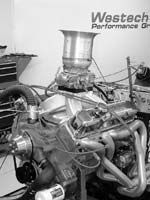
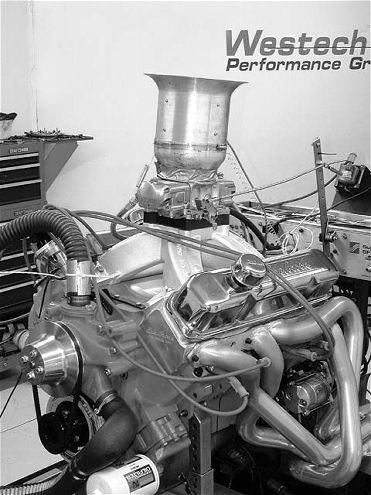
One of last year's most successful buildups in Car Craft's big-block engineseries was the Mopar 440. Featured in "Mo-Power: 535hp 440" (Nov. '01), the 0.060-over, 10.23:1 mill originally churned out 535.5 hp and 589.9 lb-ft of torque equipped with a relatively mild Comp Cams XE274H Xtreme Energy hydraulic flat-tappet cam, 1.6:1 shaft-mounted roller rockers, a 750-cfm Demon carb, an Edelbrock Performer RPM intake with a four-hole spacer, and Hooker headers (2-inch primaries into 3.5-inch collectors).
Since the original buildup, several new products have appeared with the potential to enhance this engine's performance even further. Edelbrock has a new single-plane 440 Victor intake designed for top-end power, while Comp Cams now offers dedicated Xtreme Energy High-Lift cam profiles optimized for the Mopar's larger lifter foot diameter. We couldn't wait to try them out on our already-strong Mopar 448ci engine.
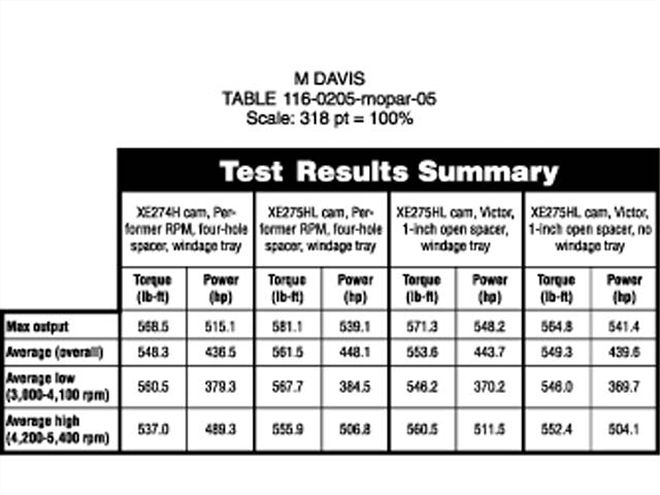
The Mopar and Pontiac were the only engines in the six-engine buildup series to utilize oil pan windage trays. Several readers felt this gave the Mopar an unfair advantage, so the engine was also rerun with and without the tray to see just how much it was really worth.
At Westech Performance, our dyno facility, we first tested the cam, then swapped the manifold, and finally removed the windage tray. The tests summarized here prove quite revealing, but there's one fly in the soup: When the engine was rebaselined in its original configuration it was down about 20 hp and 14 lb-ft from last year's peaks. In the interim our poor abused 440 had been put through a major cam flog that apparently had taken its toll on the valvesprings (That's what we get for loaning it to a friend!). Due to tight magazine deadlines, there was no time to freshen them up, so the numbers from the current test series should only be compared within themselves, not against last year's results. With fresh valvesprings we'd probably be up another 15-20 hp at the peak.
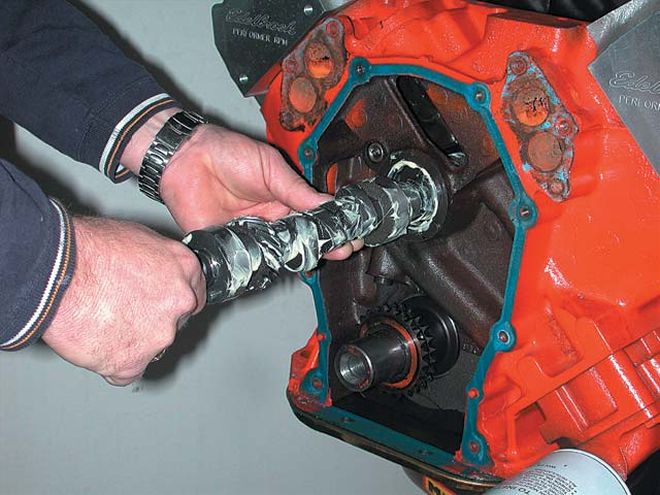 Designed to take advantage of the large-diameter Mopar lifter, Comp's Xtreme Energy Hi-Lift 275 cam raised the baseline XE274H cam's peak output from 569 lb-ft/ 515 hp to 581 lb-ft/539 hp. Overall average power and torque numbers were up about 2.5 percent over the original cam.
Designed to take advantage of the large-diameter Mopar lifter, Comp's Xtreme Energy Hi-Lift 275 cam raised the baseline XE274H cam's peak output from 569 lb-ft/ 515 hp to 581 lb-ft/539 hp. Overall average power and torque numbers were up about 2.5 percent over the original cam.
Cam vs. Cam
With flat-tappet cams, the maximum permissible tappet velocity is directly proportional to the tappet diameter. A larger-diameter tappet allows the use of a profile with more aggressive lift versus duration specs. Profiles developed with higher maximum velocity can have more area and more lift for a given duration than similar profiles with less maximum velocity. Mopar engines have a 0.904-inch lifter-foot diameter, compared to 0.842 inch for most GM applications. This gives Mopars a theoretical advantage when restricted to a flat-tappet profile--provided the profile is ground to take advantage of it.Since our original buildup, Comp Cams has introduced Xtreme Energy Hi-Lift cams for Mopars big- and small-block engines. Specifically designed to take advantage of Mopar's big 0.904-inch-od lifter, also used in AMC engines, the new hydraulic flat-tappet profiles up the ante on the already aggressive standard Xtreme Energy series. Standard Xtreme Energy cams already generate more lift than old-tech cams for a given duration range--which yields more top-end power without sacrificing low-end performance--so we couldn't wait to run the even quicker Mopar grinds.
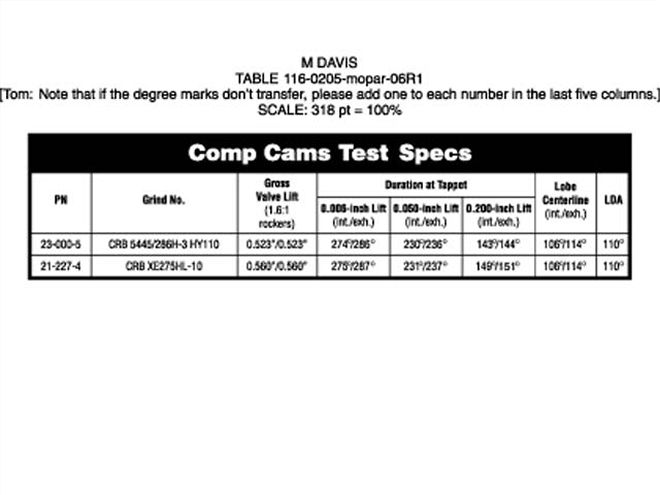
We tested last year's original Xtreme Energy 274H cam (a custom grind in our case for compatibility with a three-bolt cam sprocket) against Comp's new Xtreme Energy 275HL grind. The new HL cam has about the same duration at 0.050-inch lift, yet 0.037 inch more valve-lift (with 1.6:1 rockers), than the equivalent regular Xtreme Energy grind, which was really designed to work with 0.842-inch tappets (see spec chart). However, by 0.200-inch lift, the more aggressive lobe is able to generate about 6 degrees more duration with the bigger lifter. For the comparison, the engine was equipped with the same Edelbrock Performer RPM intake and 1-inch tall four-hole spacer used in the previous test.
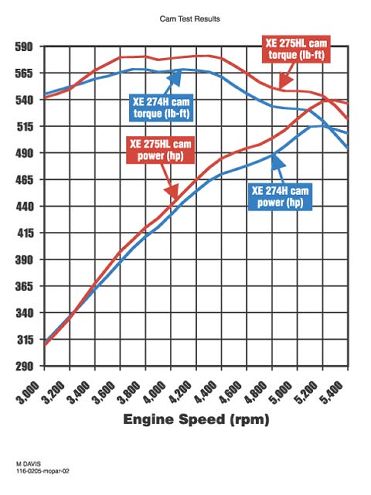
The cam certainly lived up to its billing, gaining 24 hp and nearly 13 lb-ft at the peaks. The torque peak rose 600 rpm (from 3,700 to 4,300 rpm), while power peaked 100 rpm higher. Although the HL cam was down slightly below 3,300 rpm, above that point it yielded better torque and power numbers at every test rpm increment, and the gap between the cams increased as rpm went up.
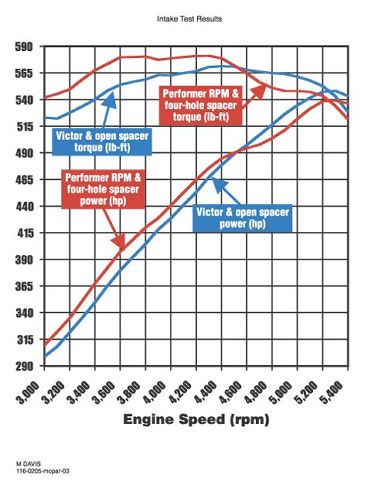
Intake vs. Intake
The basic rule of thumb on intake manifolds is: High-rise dual-plane intakes yield a broader torque curve than a single-plane, but a state-of-the-art race-oriented single-plane is stronger on top--particularly over 6,500 rpm. Note the emphasis on race--our recent experience has been that Edelbrock's Performer RPM series outperforms old-style street single-planes throughout the engine's operating range. This certainly held true in the 440's case, where in the original buildup the RPM thoroughly trounced an old school Torker.At the time, Edelbrock didn't offer a modern Victor-series single-plane for the big Mopar, but it introduced a full-on Victor 440 (not Victor Jr.) at the 2001 SEMA show. Edelbrock says the Victor's all-new runner design will work from 3,500 to 7,500 rpm, but they were uncertain how it would perform on a "mild" 440 that peaked out well under 5,500. It was with some trepidation that Edelbrock gave us a prototype to try out.
Both the RPM and Victor were compared with the 275HL cam installed in the motor. The RPM performed best with a 1-inch-tall four-hole spacer, but the Victor turned in its best numbers using a 1-inch open spacer. The Victor raised the torque and power peaks another 100 rpm, gaining 9 hp on top, but at the cost of nearly 10 lb-ft of torque (peak-to-peak). On this engine the Victor was stronger than the RPM above 4,500 rpm, but (as expected) it achieved these gains at the expense of low- and midrange performance. In terms of the overall curve, the Performer RPM turned in the best average numbers. Nevertheless, a stick-shift car with steep rear gears might run harder at the drags with the Victor. This test also hints at the Victor's true high-rpm potential with a solid-roller cam. Bracket racers, watch out.
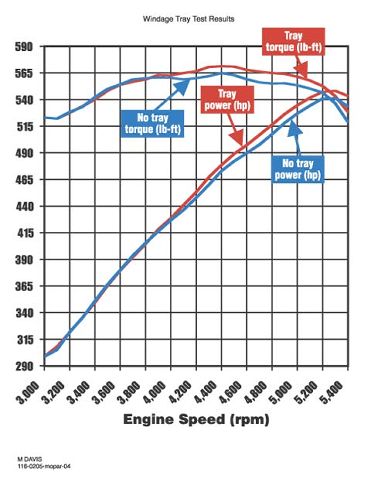
Tray vs. No Tray
In theory, an oil pan windage tray drains the oil away from the crank and at the same time prevents the rotating crank throws from hitting an accumulation of oil. This is said to reduce frictional losses as well as fight oil foaming and aeration. Milodon, which makes the louvered tray used in our 440 buildup, maintains that it "can add about 12 to 15 hp" on a 400hp street engine. We decided to put this to the test. Westech removed the tray from the Victor intake/275HL cam combo and ran one last test. We found the tray really only starts working over 4,000 rpm; below that point it made virtually no difference in power and torque output. However, at the peaks we saw 6.5 lb-ft and nearly 7 hp. Of course, a static dyno can't duplicate acceleration, braking, and cornering loads that can really ruin your whole day with a marginal oiling system.